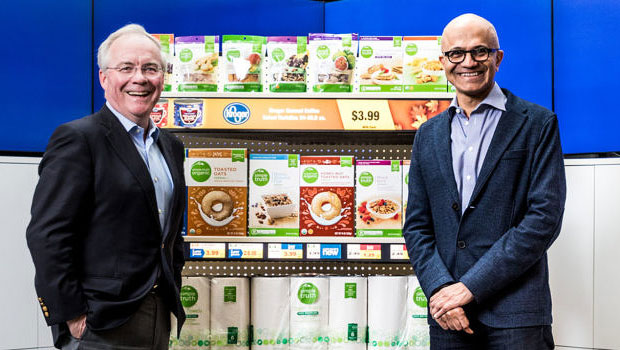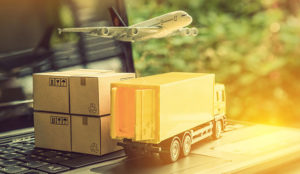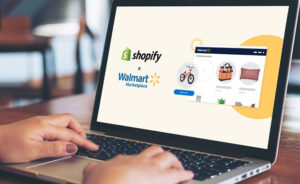Microsoft and Kroger on Monday announced a collaboration on Retail as a Service, or RaaS, to equip retail stores with Kroger Technology products that run on Microsoft Azure.
The technology utilizes the Internet of Things, connectivity, the cloud, and data collection and analysis to improve both customer experiences and store bottom lines.
Two stores will pilot a smart technology system from the Kroger Technology team, which is connected by IoT sensors and runs on Microsoft Azure. One is located in Monroe, Ohio, near Kroger’s Cincinnati headquarters. The other is in Redmond, Washington, near Microsoft’s main campus.
The pilots will use the latest generation of Kroger’s Enhanced Display for Grocery Environment (EDGE), a shelving system that uses digital displays instead of traditional paper tags for everything from prices and promotions to nutritional and dietary information.
Using Microsoft Azure AI, EDGE Shelf will connect with Kroger’s Scan, Bag, Go app, available on Google Play and at the Apple App Store, to create a guided shopping experience. EDGE Shelf will highlight products a customer wants to purchase, and it can help customers select items based on their preferences.
Microsoft Azure will store and process the data generated in-store, near the EDGE shelves, and on the Scan, Bag, Go app.
Video analytics running on Azure will let stores present personalized ads to consumers, and will help store associates identify out-of-stock items and take appropriate steps in response. Further, a pick-to-light productivity solution will use visual cues to help store associates quickly find items for curbside pickup orders.
The EDGE shelves will let Kroger sell digital advertising space to consumer packaged goods brands. Further, brands can use video analytics to present personalized offers and advertisements based on customer demographics.
The pilot will guide expansion this year and beyond.
Kroger has been using Restock Kroger to identify partners that will “help us reinvent the customer experience and create new profit streams,” Kroger CEO Rodney McMullen said.
Last year, Kroger introduced EDGE at 120 stores in all, following a pilot in which EDGE shelves were used in 16 stores.
The Joys of Guided Shopping
“Guided shopping directs shoppers through the store [using] the Scan, Bag, Go app on the most efficient route using aisle location information,” said Carley Petersen of Microsoft PR firm WE Communications.
“When a customer approaches the digital shelf, they will see their item highlighted with their assigned avatar,” she told the E-Commerce Times.
There are currently 18 food-themed avatars, including pumpkins, bananas and avocados.
After scanning an item, the app switches to the next item on the customer’s shopping list, Petersen said.
Scan, Bag Go lets customers see a running total of their grocery spending and then check out by barcode, she noted.
Putting Up Ads
Selling ad space using the EDGE Shelf will generate new revenue for Kroger.
Consumers will be presented personalized offers and ads based on facial recognition if they opt into using this technology.
“Our customers’ trust is our priority,” Petersen said. “It’s opt-in only by the customer. We’re committed to rigorous standards for our data security.”
The facial recognition system will identify a customer’s age and gender.
The idea is not to gain data about individual customers, but about customers’ behaviors and patterns, said Ray Wang, principal analyst at Constellation Research.
The technology will let stores “see what are the hot promotional items, which aisles and goods are more effective, and what offers are working,” he told the E-Commerce Times.
Ads put up by the EDGE Shelves will be based on customers’ shopping history, Petersen said. “Over time, the Kroger system will learn, for example, that a shopper doesn’t buy meat, and won’t advertise meat to them but instead may show vegan or vegetarian options.”
Pilot advertisers include Procter & Gamble, Kraft/Heinz, and Pepsi, Petersen disclosed.
The greatest opportunity RaaS technology provides is in raising revenue from ads, noted Rebecca Wettemann, VP of research at Nucleus Research.
However, retailers “will have to balance consumer privacy concerns and walk the fine line between helpful and creepy when tailoring in-store digital content to individual customers,” she told the E-Commerce Times.
The Impact of Technological Solutions
“As brick-and-mortar retailers look to differentiate their services, providing a more interactive digital experience in stores and better enabling employees to guide, and not just check out, customers are important areas of opportunity,” Wettemann said.
“There’s another opportunity in reducing the cost of updating price tags on items and in-store signs and shelving,” she pointed out. “Although it’s less sexy than the interactive buying experience they’re pitching, it can represent significant cost savings for retailers with a broad number of SKUs and a lot of price fluctuation, like groceries.”
That is one of the benefits of RaaS solutions Kroger and Microsoft have been highlighting.
While the announcement is a big one because of the size of the players involved, the approach is not new, Wettemann pointed out.
“Smaller players, such as ECS Global, have been working with retailers to introduce digital signage and interactivity for consumers for some time,” she observed. “The Microsoft-Kroger partnership should raise the visibility of existing solutions like ECS.”
Future Plans
The success of the pilots will determine Kroger’s expansion in 2019 and beyond.
Pilot programs are not limited to the two stores in Redmond and Monroe. Kroger also has begun testing end cap displays at 92 stores in the Cincinnati area, Petersen said.
Kroger and Microsoft have been working on RaaS for 18 months.
Marketing the jointly developed RaaS product will “create a new profit stream for Kroger and [let] retailers save R&D capital,” Petersen added.
The commercial RaaS product probably will be marketed in Q4 this year, Constellation’s Wang predicted.
The product likely will be welcomed by the retail industry, he said, for two reasons.
First, it offers an alternative to Amazon.
“This is about taking out Amazon,” Wang remarked. “Retailers are choosing Microsoft or Google to beat Amazon.”
Second, more data means better customer models.
“This helps everyone out,” Wang noted.
Other retailers purchasing the Kroger-Microsoft solution need not fear giving Kroger a foothold in their shops, because “they typically have Chinese firewalls on this,” Wang pointed out.
However, RaaS solutions must have “a clear and immediate impact on reducing costs, or driving increased purchases, to warrant broader adoption,” said Nucleus Research’s Wettemann, “given the razor-thin margins in retail markets like grocery.”
























































Social Media
See all Social Media